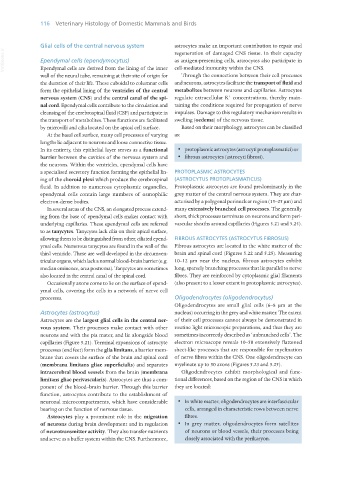Page 134 - Veterinary Histology of Domestic Mammals and Birds, 5th Edition
P. 134
116 Veterinary Histology of Domestic Mammals and Birds
Glial cells of the central nervous system astrocytes make an important contribution to repair and
VetBooks.ir Ependymal cells (ependymocytus) regeneration of damaged CNS tissue. In their capacity
as antigen-presenting cells, astrocytes also participate in
Ependymal cells are derived from the lining of the inner cell-mediated immunity within the CNS.
wall of the neural tube, remaining at their site of origin for Through the connections between their cell processes
the duration of their life. These cuboidal to columnar cells and neurons, astrocytes facilitate the transport of fluid and
form the epithelial lining of the ventricles of the central metabolites between neurons and capillaries. Astrocytes
nervous system (CNS) and the central canal of the spi- regulate extracellular K concentrations, thereby main-
+
nal cord. Ependymal cells contribute to the circulation and taining the conditions required for propagation of nerve
cleansing of the cerebrospinal fluid (CSF) and participate in impulses. Damage to this regulatory mechanism results in
the transport of metabolites. These functions are facilitated swelling (oedema) of the nervous tissue.
by microvilli and cilia located on the apical cell surface. Based on their morphology, astrocytes can be classified
At the basal cell surface, many cell processes of varying as:
lengths lie adjacent to neurons and loose connective tissue.
In its entirety, this epithelial layer serves as a functional · protoplasmic astrocytes (astrocyti protoplasmatici) or
barrier between the cavities of the nervous system and · fibrous astrocytes (astrocyti fibrosi).
the neurons. Within the ventricles, ependymal cells have
a specialised secretory function forming the epithelial lin- PROTOPLASMIC ASTROCYTES
ing of the choroid plexi which produce the cerebrospinal (ASTROCYTUS PROTOPLASMATICUS)
fluid. In addition to numerous cytoplasmic organelles, Protoplasmic astrocytes are found predominantly in the
ependymal cells contain large numbers of osmophilic grey matter of the central nervous system. They are char-
electron-dense bodies. acterised by a polygonal perinuclear region (15–25 μm) and
In several areas of the CNS, an elongated process extend- many extensively branched cell processes. The generally
ing from the base of ependymal cells makes contact with short, thick processes terminate on neurons and form peri-
underlying capillaries. These ependymal cells are referred vascular sheaths around capillaries (Figures 5.21 and 5.25).
to as tanycytes. Tanycytes lack cilia on their apical surface,
allowing them to be distinguished from other, ciliated epend- FIBROUS ASTROCYTES (ASTROCYTUS FIBROSUS)
ymal cells. Numerous tanycytes are found in the wall of the Fibrous astrocytes are located in the white matter of the
third ventricle. These are well developed in the circumven- brain and spinal cord (Figures 5.22 and 5.25). Measuring
tricular organs, which lack a normal blood–brain barrier (e.g. 10–12 μm near the nucleus, fibrous astrocytes exhibit
median eminence, area postrema). Tanycytes are sometimes long, sparsely branching processes that lie parallel to nerve
also located in the central canal of the spinal cord. fibres. They are reinforced by cytoplasmic glial filaments
Occasionally axons come to lie on the surface of epend- (also present to a lesser extent in protoplasmic astrocytes).
ymal cells, covering the cells in a network of nerve cell
processes. Oligodendrocytes (oligodendrocytus)
Oligodendrocytes are small glial cells (6–8 μm at the
Astrocytes (astrocytus) nucleus) occurring in the grey and white matter. The extent
Astrocytes are the largest glial cells in the central ner- of their cell processes cannot always be demonstrated in
vous system. Their processes make contact with other routine light microscopic preparations, and thus they are
neurons and with the pia mater, and lie alongside blood sometimes incorrectly described as ‘unbranched cells’. The
capillaries (Figure 5.21). Terminal expansions of astrocyte electron microscope reveals 10–50 extensively flattened
processes (end feet) form the glia limitans, a barrier mem- sheet-like processes that are responsible for myelination
brane that covers the surface of the brain and spinal cord of nerve fibres within the CNS. One oligodendrocyte can
(membrana limitans gliae superficialis) and separates myelinate up to 50 axons (Figures 5.23 and 5.25).
intracerebral blood vessels from the brain (membrana Oligodendrocytes exhibit morphological and func-
limitans gliae perivascularis). Astrocytes are thus a com- tional differences, based on the region of the CNS in which
ponent of the blood–brain barrier. Through this barrier they are located:
function, astrocytes contribute to the establishment of
neuronal microcompartments, which have considerable · In white matter, oligodendrocytes are interfascicular
bearing on the function of nervous tissue. cells, arranged in characteristic rows between nerve
Astrocytes play a prominent role in the migration fibres.
of neurons during brain development and in regulation · In grey matter, oligodendrocytes form satellites
of neurotransmitter activity. They also transfer nutrients of neurons or blood vessels, their processes being
and serve as a buffer system within the CNS. Furthermore, closely associated with the perikaryon.
Vet Histology.indb 116 16/07/2019 14:57

